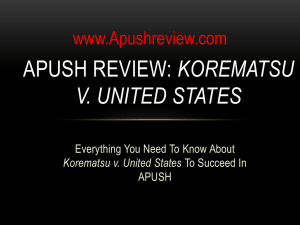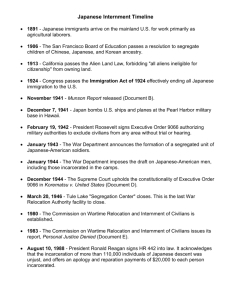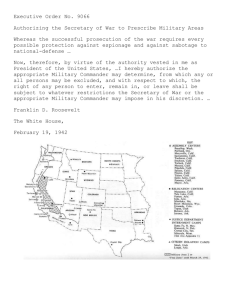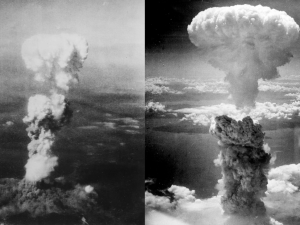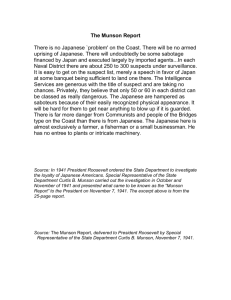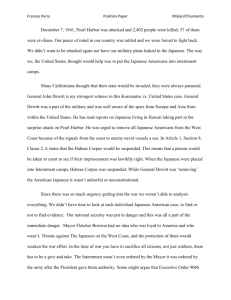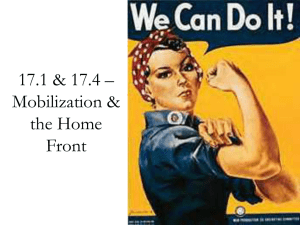Document B: The Munson Report
advertisement
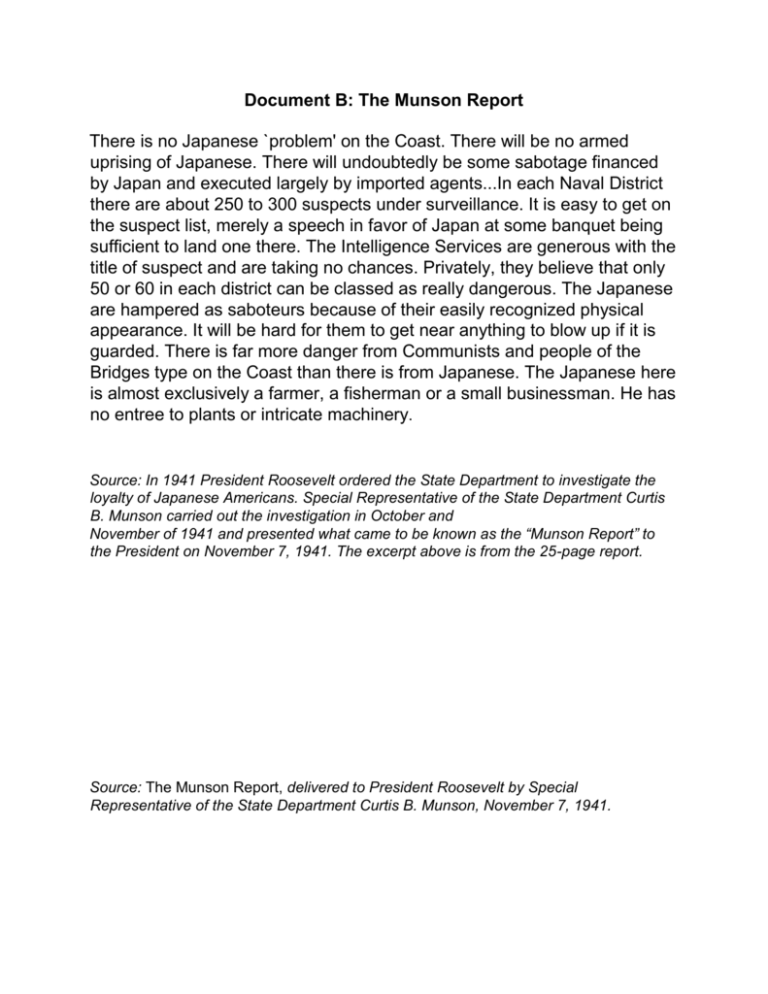
Document B: The Munson Report There is no Japanese `problem' on the Coast. There will be no armed uprising of Japanese. There will undoubtedly be some sabotage financed by Japan and executed largely by imported agents...In each Naval District there are about 250 to 300 suspects under surveillance. It is easy to get on the suspect list, merely a speech in favor of Japan at some banquet being sufficient to land one there. The Intelligence Services are generous with the title of suspect and are taking no chances. Privately, they believe that only 50 or 60 in each district can be classed as really dangerous. The Japanese are hampered as saboteurs because of their easily recognized physical appearance. It will be hard for them to get near anything to blow up if it is guarded. There is far more danger from Communists and people of the Bridges type on the Coast than there is from Japanese. The Japanese here is almost exclusively a farmer, a fisherman or a small businessman. He has no entree to plants or intricate machinery. Source: In 1941 President Roosevelt ordered the State Department to investigate the loyalty of Japanese Americans. Special Representative of the State Department Curtis B. Munson carried out the investigation in October and November of 1941 and presented what came to be known as the “Munson Report” to the President on November 7, 1941. The excerpt above is from the 25-page report. Source: The Munson Report, delivered to President Roosevelt by Special Representative of the State Department Curtis B. Munson, November 7, 1941. Document C: The Crisis Along the eastern coast of the United States, where the numbers of Americans of Japanese ancestry is comparatively small, no concentration camps have been established. From a military point of view, the only danger on this coast is from Germany and Italy…But the American government has not taken any such high-handed action against Germans and Italians – and their American-born descendants – on the East Coast, as has been taken against Japanese and their American-born descendants on the West Coast. Germans and Italians are “white.” Color seems to be the only possible reason why thousands of American citizens of Japanese ancestry are in concentration camps. Anyway, there are no Italian-American, or German-American citizens in such camps. Source: Harry Paxton Howard, “Americans in Concentration Camps,” The Crisis, September, 1942. Founded in 1910, The Crisis is one of the oldest black periodicals in America. The publication is dedicated to promoting civil rights. The excerpt above is from an editorial that appeared soon after the establishment of internment camps. Document D: The Korematsu Supreme Court Ruling We uphold the exclusion order as of the time it was made and when the petitioner violated it….In doing so, we are not unmindful of the hardships imposed by it upon a large group of American citizens….But hardships are part of war, and war is an aggregation of hardships. All citizens alike, both in and out of uniform, feel the impact of war in greater or lesser measure. Citizenship has its responsibilities, as well as its privileges, and, in time of war, the burden is always heavier. Compulsory exclusion of large groups of citizens from their homes, except under circumstances of direst emergency and peril, is inconsistent with our basic governmental institutions. But when, under conditions of modern warfare, our shores are threatened by hostile forces, the power to protect must be commensurate with the threatened danger… To cast this case into outlines of racial prejudice, without reference to the real military dangers which were presented, merely confuses the issue. Korematsu was not excluded from the Military Area because of hostility to him or his race. He was excluded because we are at war with the Japanese Empire, because the properly constituted military authorities feared an invasion of our West Coast and felt constrained to take proper security measures, because they decided that the military urgency of the situation demanded that all citizens of Japanese ancestry be segregated from the West Coast temporarily, and, finally, because Congress, reposing its confidence in this time of war in our military leaders -- as inevitably it must - determined that they should have the power to do just this. Source: In 1944, Fred Korematsu, a Japanese American convicted of evading internment, brought his case to the Supreme Court. In a controversial ruling, the Court decided that national security outweighed Korematsu’s individual rights and upheld the constitutionality of Executive Order 9066. The excerpt above is from the Court’s majority opinion written by Chief Justice Hugo Black. Document E: “Personal Justice Denied” The Commission held 20 days of hearings in cities across the country, particularly on the West Coast, hearing testimony from more than 750 witnesses: evacuees, former government officials, public figures, interested citizens, and historians and other professionals who have studied the subjects of Commission inquiry. An extensive effort was made to locate and to review the records of government action and to analyze other sources of information including contemporary writings, personal accounts and historical analyses… . . .Executive Order 9066 was not justified by military necessity, and the decisions which followed from it—detention, ending detention and ending exclusion—were not driven by analysis of military conditions. The broad historical causes which shaped these decisions were race prejudice, war hysteria and a failure of political leadership. Widespread ignorance of Japanese Americans contributed to a policy conceived in haste and executed in an atmosphere of fear and anger at Japan. A grave injustice was done to American citizens and resident aliens of Japanese ancestry who, without individual review or any…evidence against them, were excluded, removed and detained by the United States during World War II. Source: In 1980, Congress established the Commission on Wartime Relocation and Internment of Civilians to investigate the detention program and the constitutionality of Executive Order 9066. The Commission released its report “Personal Justice Denied: The Report of the Commission on Wartime Relocation and Internment of Civilians” on February 24, 1983. The passage above is an excerpt from this report.

